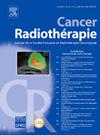Cyberneo trial investigating the efficacy of stereotactic radiotherapy combined to neoadjuvant chemotherapy for locally advanced breast cancer: 14-years follow-up results
IF 1.4
4区 医学
Q4 ONCOLOGY
引用次数: 0
Abstract
Purpose
The purpose of the phase I trial named “Cyberneo” was to define the efficacy of the stereotactic radiotherapy using CyberKnife® for locally advanced (stage III) breast tumours combined to a neoadjuvant chemotherapy for patients for whom a conservative surgery could not be considered at the onset. Neoadjuvant chemotherapy consisted of six cycles: three cycles of docetaxel and three cycles of the combination of 5-fluorouracil, epirubicin and cyclophosphamide. Stereotactic radiotherapy using CyberKnife® was performed during the second cycle of chemotherapy. Breast surgery was performed 6 to 8 weeks later and conventional breast irradiation without boost, afterwards. The main objective was to define the maximum tolerated dose of hypofractionated radiotherapy concurrent with neoadjuvant chemotherapy. We present an updated survival data for patients included in this trial and we evaluate the late toxicity of this combination.
Patients and methods
We updated the survival data of 25 patients treated for a stage III breast cancer between 2007 and 2009 at the Antoine-Lacassagne centre in Nice and included in the Cyberneo trial by recording late toxicity events and aesthetic results.
Results
With a median follow-up of 12 years (95 % confidence interval [CI]: 10–14 years), 19 patients were in remission (76 %), one patient had a controlled axillary lymph node relapse (4 %) and five patients (20 %) died due to metastatic progression within a median of 5 years after treatment (range: 1–9 years). Nine patients had a complete histological response (36 %). The highest percentage of complete histological response was in the group of patients treated in the fourth stage (28.5 Gy in four fractions). Overall survival rate at 14 years was 71 % (95 % CI: [53–94 %]). Two patients developed chronic radiation toxicity during follow-up with a fibrosis (8 %) of which one was in the fourth stage and one in the fifth stage (31.5 Gy). Three patients (12 %) had a change of prosthesis after treatment, which for one patient was 24 months after the end of support.
Conclusion
The updated results of the Cyberneo trial with 14 years of follow-up confirm the satisfactory results in terms of local control with an excellent long-term safety profile.
Cyberneo试验研究立体定向放疗联合新辅助化疗治疗局部晚期乳腺癌的疗效:14年随访结果
目的:Cyberneo I期临床试验的目的是确定使用CyberKnife®立体定向放疗治疗局部晚期(III期)乳腺肿瘤,并结合新辅助化疗治疗那些一开始就不能考虑保守手术的患者的疗效。新辅助化疗包括6个周期:多西紫杉醇3个周期和5-氟尿嘧啶、表柔比星、环磷酰胺联合3个周期。在第二周期化疗期间使用射波刀进行立体定向放疗。6 ~ 8周后进行乳房手术,之后进行常规乳房照射。主要目的是确定低分割放疗与新辅助化疗同时进行的最大耐受剂量。我们提供了该试验中患者的最新生存数据,并评估了该组合的晚期毒性。患者和方法我们更新了2007年至2009年间在尼斯Antoine-Lacassagne中心接受治疗的25例III期乳腺癌患者的生存数据,并通过记录晚期毒性事件和美学结果纳入了Cyberneo试验。结果中位随访12年(95%可信区间[CI]: 10-14年),19例患者缓解(76%),1例患者腋窝淋巴结复发得到控制(4%),5例患者(20%)在治疗后中位5年内(范围:1-9年)因转移进展死亡。9例患者有完全的组织学反应(36%)。完全组织学反应百分比最高的是在第四期治疗的患者组(28.5 Gy,分四组)。14年总生存率为71% (95% CI:[53 - 94%])。2例患者在随访期间出现慢性辐射毒性并纤维化(8%),其中1例处于第四期,1例处于第五期(31.5 Gy)。3例患者(12%)在治疗后更换假体,其中1例患者在停止支持后24个月更换假体。结论经过14年的随访,Cyberneo试验的最新结果在局部控制方面取得了令人满意的结果,并具有良好的长期安全性。
本文章由计算机程序翻译,如有差异,请以英文原文为准。
求助全文
约1分钟内获得全文
求助全文
来源期刊

Cancer Radiotherapie
医学-核医学
CiteScore
2.20
自引率
23.10%
发文量
129
审稿时长
63 days
期刊介绍:
Cancer/radiothérapie se veut d''abord et avant tout un organe francophone de publication des travaux de recherche en radiothérapie. La revue a pour objectif de diffuser les informations majeures sur les travaux de recherche en cancérologie et tout ce qui touche de près ou de loin au traitement du cancer par les radiations : technologie, radiophysique, radiobiologie et radiothérapie clinique.
 求助内容:
求助内容: 应助结果提醒方式:
应助结果提醒方式:


